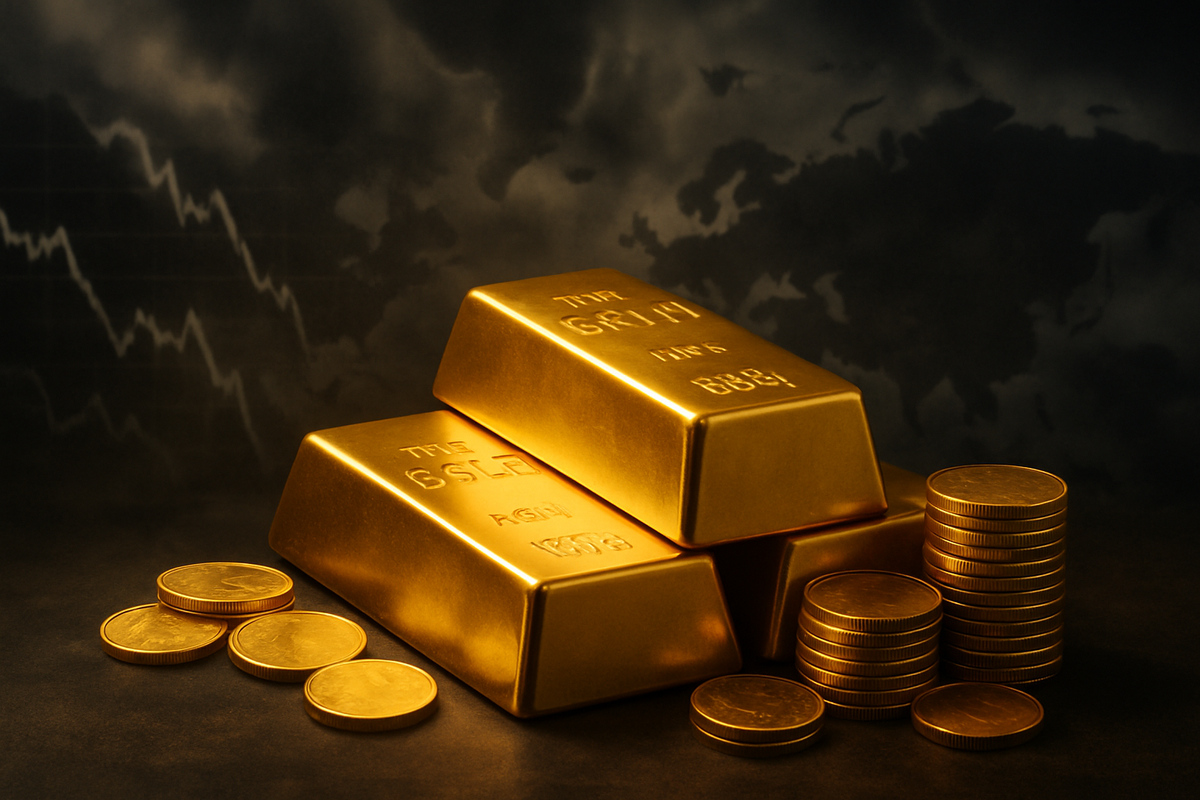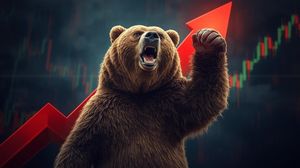
As global uncertainties continue to cast a long shadow over financial markets, gold has unequivocally reaffirmed its role as the ultimate safe-haven asset, soaring to unprecedented heights. On October 9, 2025, the precious metal breached the significant $4,000 per ounce mark, reaching an all-time high of $4,059.05, and currently trades around $3,990.10 USD/t.oz as of October 10, 2025. This remarkable rally, representing a staggering 50% gain since the beginning of the year and a 250% increase over the past three years, underscores a widespread investor flight to safety amidst a volatile economic and geopolitical landscape. The immediate implication is a reinforced bullish outlook for gold, serving as a critical hedge against inflation and a tangible store of value in an era of diminishing trust in traditional financial assets.
A Golden Ascent: Navigating a World of Uncertainty
Gold's meteoric rise is a direct reflection of a complex web of economic anxieties and escalating geopolitical tensions that have gripped the world throughout 2024 and 2025. The precious metal's journey to record highs began with a robust 25% climb in 2024, setting 40 new all-time highs and peaking around US$2,778 per ounce by late October 2024. This momentum accelerated into 2025, with gold breaking above US$3,000 per ounce for the first time by March, culminating in its recent breach of the $4,000 threshold. This consistent upward trajectory highlights gold's enduring appeal as a sanctuary asset.
The timeline of events leading to this moment is punctuated by a series of unsettling developments. Economically, persistent inflation, stubbornly remaining above target levels in major economies, has been a primary driver. Expectations of future interest rate cuts by the U.S. Federal Reserve (Fed), following actual reductions by the Bank of England and European Central Bank in late 2024/early 2025, have reduced the opportunity cost of holding non-yielding gold. Furthermore, a weakening U.S. dollar, alongside its gradual decline in global currency reserves, has made gold more attractive to international investors. The ongoing U.S. government shutdown in October 2025, renewed trade wars initiated by U.S. President Donald Trump in April 2025, and warnings from the IMF about "uncertainty is the new normal" have all fueled widespread economic anxiety. Adding to this, concerns from the Bank of England about a potential AI bubble bursting and rising government debt globally, particularly in the U.S. and China, paint a picture of fiscal stress.
Geopolitically, the landscape is equally fraught. The prolonged Eastern European conflict (Russia-Ukraine, 2022-2025) and persistent tensions in the Middle East, notably the October 2023 Hamas attack on Israel, continue to exert upward pressure on gold prices, often triggering inflation expectations and currency devaluations. Domestic political instability in key nations, such as the U.S. government shutdown, the resignation of Prime Minister Sebastien Lecornu in France, and a significant leadership election in Japan, further contribute to global uncertainty. Escalating US-China tensions, characterized by renewed tariff threats and China's strategic limits on rare earth element trade, are also major drivers of market volatility. These factors collectively underscore a fragmented global order, where nations are re-evaluating resource security and trade barriers, inherently increasing uncertainty and benefiting gold. Key stakeholders benefiting from this include central banks globally, particularly in Asia and the Middle East, who have been diversifying their reserves by acquiring gold at an unprecedented rate, providing a strong and consistent underlying demand. Individual and institutional investors seeking portfolio diversification and protection against economic instability are also significant players.
Winners and Losers in the Golden Rush
The sustained rally in gold prices creates a clear delineation of winners and losers across the financial markets. Gold mining companies are undoubtedly among the primary beneficiaries. Companies like Barrick Gold Corporation (NYSE: GOLD), Newmont Corporation (NYSE: NEM), and Kinross Gold Corporation (NYSE: KGC) stand to see significant increases in their revenue and profit margins as the price of their primary commodity surges. Higher gold prices directly translate to more profitable operations, potentially leading to increased exploration budgets, expanded production, and enhanced shareholder returns through dividends or buybacks. Precious metal investment funds and gold-backed Exchange Traded Funds (ETFs) such as SPDR Gold Shares (NYSEARCA: GLD) are also experiencing substantial inflows, driving up their asset under management and performance metrics.
Conversely, a flight to safety often signals a retreat from riskier assets, impacting various sectors negatively. High-growth technology companies and other speculative investments, which thrive in periods of economic optimism and lower interest rates, may face headwinds as investors become more risk-averse. Financial institutions with significant exposure to volatile credit markets or emerging market debt could also experience pressure. Furthermore, industries heavily reliant on global trade and stable supply chains, such as automotive manufacturers or consumer electronics companies, could suffer from the trade wars and geopolitical fragmentation that are driving gold's ascent. A stronger gold price can also indirectly put pressure on the U.S. dollar, potentially affecting companies with large international operations or those that import goods priced in other currencies.
Broader Implications and Historical Echoes
Gold's current performance is more than just a market anomaly; it fits squarely into broader industry trends signaling a profound shift in global economic and geopolitical dynamics. This sustained demand for gold is indicative of a move towards de-dollarization by central banks and a growing global desire for inflation hedging. Central banks' unprecedented accumulation of gold, forecasted by Goldman Sachs to continue robustly through 2025 and 2026, reflects a strategic pivot away from traditional reserve currencies and a re-evaluation of national financial security. This trend has ripple effects, potentially accelerating the diversification of global reserves and influencing the stability of fiat currencies.
The regulatory and policy implications are significant. Persistent inflation and the ongoing U.S. government shutdown could pressure central banks to reconsider their monetary policy stances, even if rate cuts were previously anticipated. Trade policies, particularly the reintroduction of tariffs by the U.S., threaten to fragment global supply chains further, forcing companies to re-evaluate their sourcing and production strategies. Historically, gold has always performed strongly during periods of high inflation and geopolitical instability. The 1970s, characterized by oil shocks, high inflation, and geopolitical tensions, saw gold prices skyrocket. More recently, the 2008 financial crisis and the initial phases of the COVID-19 pandemic also triggered significant rallies. The current environment, with its confluence of economic uncertainty, political instability, and military conflicts, mirrors these historical precedents, reinforcing gold's role as a timeless hedge against systemic risk.
The Road Ahead: Navigating the Golden Future
Looking ahead, the short-term outlook for gold remains robust, with analysts like ING forecasting an average price of $4,150 per ounce in 2026 and Goldman Sachs raising its December 2026 price forecast to $4,900 per ounce. The persistent global uncertainties, coupled with continued central bank buying and investor demand for portfolio diversification, suggest that gold's ascent may not be a temporary phenomenon. However, the rapid appreciation could introduce short-term volatility, with some analysts warning of potential corrections after recent peaks.
In the long term, gold's trajectory will largely depend on the resolution, or lack thereof, of the underlying global issues. Should inflation prove more transitory than expected, or if geopolitical tensions significantly de-escalate, some of the upward pressure on gold could ease. However, given the IMF's declaration of "uncertainty is the new normal," a sustained environment of risk aversion is a highly probable scenario. This necessitates potential strategic pivots for investors, focusing on assets that offer genuine diversification and inflation protection. Market opportunities may emerge in gold royalty and streaming companies, which offer exposure to gold production with lower operational risks than traditional miners. Challenges include managing the volatility inherent in such a rapidly appreciating asset and identifying genuine value amidst speculative fervor.
Potential scenarios range from a continued "gold rush" where prices consolidate around new highs, to a more moderated environment if global stability improves. Investors should brace for continued market choppiness, with gold acting as a key barometer of global confidence.
Wrapping Up: Gold's Enduring Legacy in a Fractured World
In summary, gold's unprecedented price surge to over $4,000 per ounce by October 2025 is a stark indicator of the profound economic and geopolitical uncertainties pervading the global landscape. Key takeaways include gold's undeniable status as an ultimate safe-haven, its effectiveness as an inflation hedge, and the significant role of central bank accumulation in driving its demand. The market moving forward is likely to remain volatile, characterized by persistent risk aversion and a continued search for tangible stores of value.
The lasting impact of this event is a reinforced recognition of gold's enduring legacy as a reliable asset in times of crisis. It signals a growing distrust in fiat currencies and traditional financial systems, prompting a strategic re-evaluation of portfolio allocations by both institutional and individual investors. Investors should closely watch for developments in global inflation rates, central bank monetary policies, the trajectory of geopolitical conflicts, and the stability of major currencies. These factors will continue to dictate gold's path and its role as a critical anchor in an increasingly fractured and uncertain world.
This content is intended for informational purposes only and is not financial advice





